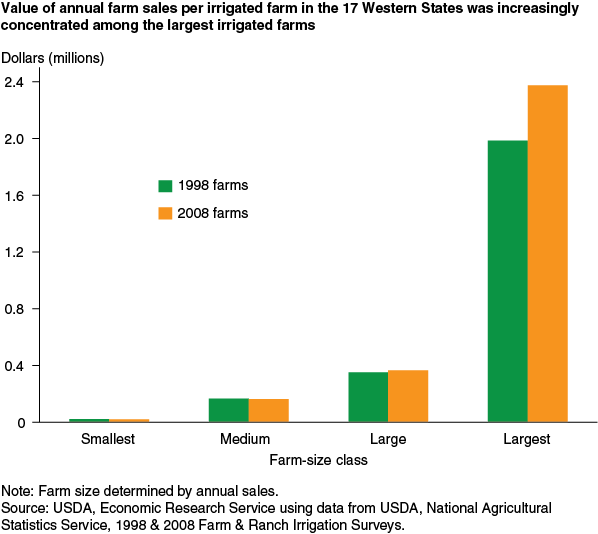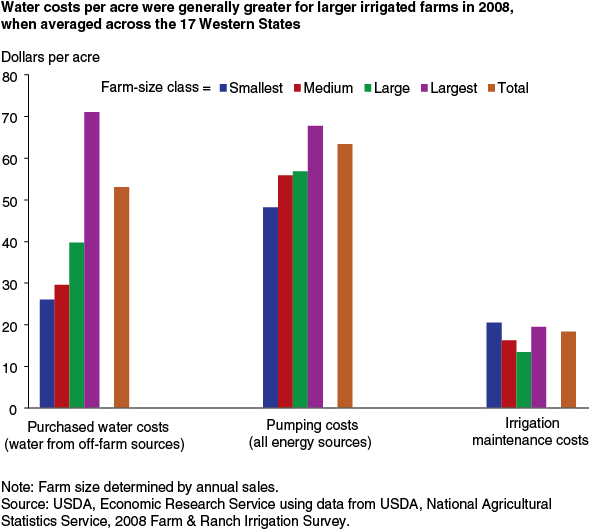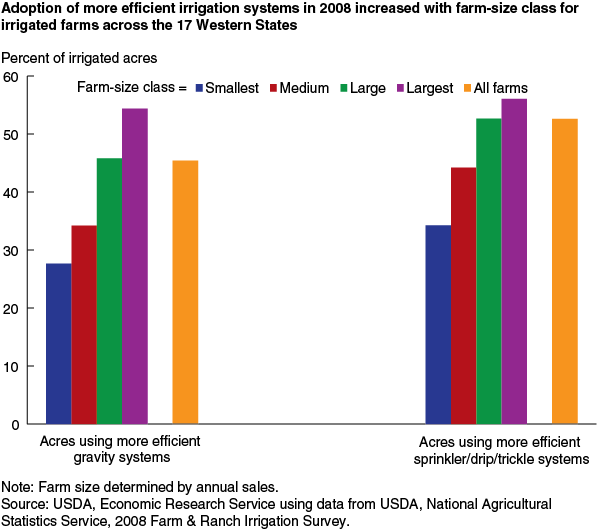Western Irrigated Agriculture: Production Value, Water Use, Costs, and Technology Vary by Farm Size
- by Glenn Schaible and Marcel Aillery
- 9/2/2013
In 2007, nearly 57 million farmland acres were irrigated across the United States (51.5 million acres of harvested cropland and 5.1 million acres of pastureland and other cropland). Nationwide, irrigated agriculture made a significant contribution to the value of U.S. agricultural production in 2007, with farms having at least some irrigated cropland accounting for roughly 40 percent of U.S. agricultural market sales. The 17 contiguous Western States accounted for nearly three-quarters of U.S. irrigated farmland in 2007.
The Largest Farms Dominate Western Irrigated Agriculture
Most irrigated farms across the 17 Western States (63 percent) are small farms, with annual sales of less than $100,000, according to the 2008 USDA Farm and Ranch Irrigation Survey (FRIS), which draws on a sample of irrigated farms identified in the 2007 Census of Agriculture. However, the largest farms (annual sales of $500,000 or more) had most of the irrigated cropland across the West, accounting for 61 percent (24.4 million acres) of the region's total irrigated acreage in 2008. The largest irrigated farms in the region averaged about 3,300 acres, of which 1,020 were irrigated in 2008; the smallest farms averaged 244 acres, of which 47 were irrigated.
Over time, the number of farms in the West with annual sales of $500,000 or more has increased, as has the share of irrigated acres on these farms. Between 1998 and 2008, the share of the region’s total farms and acres accounted for by the largest farms increased by nearly 6 percent and 20 percent, respectively. However, as some farms grew in size and changed from one size category to the next, the average farm size and the average number of irrigated acres actually declined for the largest farm group over this 10-year period.
The largest irrigated farms, representing only 15 percent of all irrigated farms in the West, accounted for 66 percent of the water applied to crop agriculture in the region in 2008. In eight Western States (Arizona, California, Idaho, Kansas, Nebraska, Oregon, Texas, and Washington), the largest farms accounted for 75 percent of applied irrigation water. The largest farms also accounted for nearly 85 percent of the total value of annual irrigated farm sales across the West, averaging slightly less than $2.4 million per farm, while small irrigated farms averaged just $20,047 per farm. These amounts, too, have changed over time as crop farm production has been consolidating on larger farms (see “Cropland Consolidation and the Future of Family Farms” in this issue of Amber Waves).
Water Costs for Irrigated Agriculture Can Vary by Farm-Size Class
Irrigators use pumps to pull water from groundwater wells, as well as to pressurize water within field application systems. Some irrigators also purchase water from off-farm suppliers (such as irrigation districts). Irrigation costs and profitability tend to vary based on available water sources, type of irrigation system used, crops irrigated, energy source used to power irrigation systems, and water costs charged for off-farm water supplies.
Average per-acre pumping costs ranged from about $48 per acre for the smallest irrigated farms in the West to nearly $68 per acre for the largest irrigated farms in 2008. The largest irrigated farms tend to depend more heavily on groundwater wells (generally a more expensive water source), while the smallest irrigated farms depend more on surface-water sources. Purchased water costs varied more across farm-size classes than other irrigation costs in 2008, ranging from $26 per acre for the smallest farms to $71 per acre for the largest farms. Volumetric-based pricing rates that increase with water use likely account for these cost differences. Irrigation maintenance and repair costs varied little across farm-size classes, averaging about $20 per acre.
Irrigation Efficiency Has Room for Improvement Among All Farm Sizes
Irrigation (water-use) efficiency is influenced heavily by choice of field-level water application system; it is also influenced by the farm/field water-management practices used to distribute water across a field and apply water at the time and in the quantity required for a given stage of a crop’s growth. Because actual water applied by irrigated farms is rarely measured, a proxy for the relative efficiency of irrigation is based on the share of acres using more efficient onfarm irrigation application systems, for gravity-flow and pressure (sprinkler and drip/trickle/micro) irrigation systems separately.
Since 1998, gravity-irrigated farmland has declined by about 4.6 million acres and pressure irrigated farmland has increased by 7.1 million acres in the West. This change is due largely to a decline in the use of gravity systems by smaller and medium-sized irrigated farms on existing irrigated acres and to greater use of pressure irrigation systems by the largest farms on both existing and new irrigated acres.
In 2008, about 45 percent of gravity-irrigated acres in the West used more efficient gravity systems (defined to include gravity-based furrow systems using above- or below-ground pipe or a lined open ditch for field water delivery, plus acres in flood irrigation on farms using laser leveling and pipe or lined open-ditch field water delivery); about 53 percent of pressure-irrigated acres in the West used the more efficient [low-pressure sprinkler (less than 30 pounds per square inch) or drip/trickle/micro] pressure systems. However, the use of higher efficiency systems varied across farm sizes. Adoption rates of efficient gravity systems ranged from 28 percent for the smallest farms to 54 percent for the largest farms. Similarly, the use of high-efficiency pressure irrigation ranged from 34 percent for the smallest to 56 percent for the largest farms.
Use of improved water-management practices can help producers maximize the economic efficiency of their irrigation systems and the potential for water savings through reduced system losses and managed reductions in crop consumptive use. However, relatively few farms make widespread use of the best water management practices and water-conserving means of deciding when and how much to irrigate.
This article is drawn from:
- Irrigated Agriculture in the United States. (n.d.). U.S. Department of Agriculture, Economic Research Service.
You may also like:
- Schaible, G. & Aillery, M. (2012). Water Conservation in Irrigated Agriculture: Trends and Challenges in the Face of Emerging Demands. U.S. Department of Agriculture, Economic Research Service. EIB-99.
We’d welcome your feedback!
Would you be willing to answer a few quick questions about your experience?





